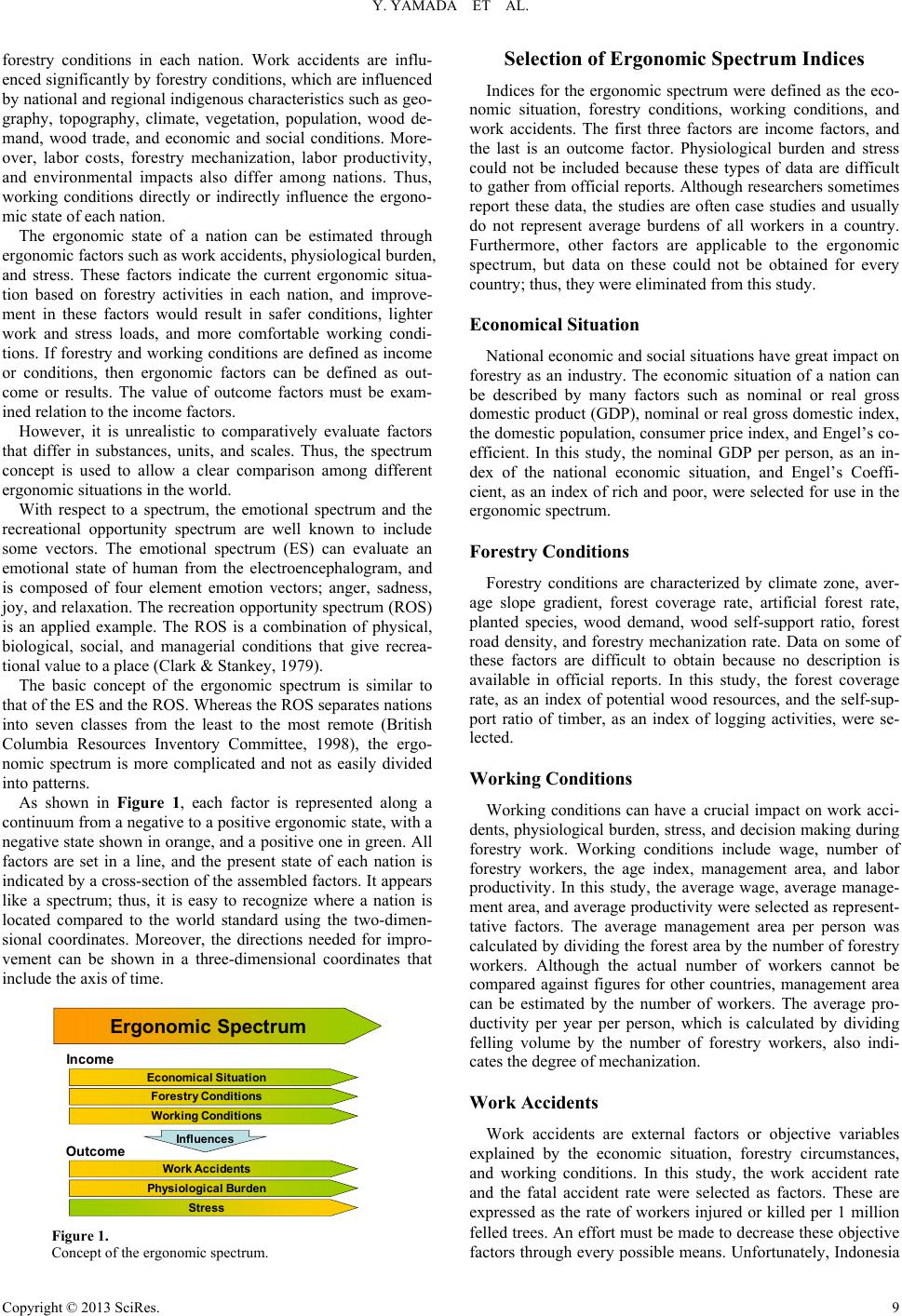
Y. YAMADA ET AL.
forestry conditions in each nation. Work accidents are influ-
enced significantly by forestry conditions, which are influenced
by national and regional indigenous characteristics such as geo-
graphy, topography, climate, vegetation, population, wood de-
mand, wood trade, and economic and social conditions. More-
over, labor costs, forestry mechanization, labor productivity,
and environmental impacts also differ among nations. Thus,
working conditions directly or indirectly influence the ergono-
mic state of each nation.
The ergonomic state of a nation can be estimated through
ergonomic factors such as work accidents, physiological burden,
and stress. These factors indicate the current ergonomic situa-
tion based on forestry activities in each nation, and improve-
ment in these factors would result in safer conditions, lighter
work and stress loads, and more comfortable working condi-
tions. If forestry and working conditions are defined as income
or conditions, then ergonomic factors can be defined as out-
come or results. The value of outcome factors must be exam-
ined relation to the income factors.
However, it is unrealistic to comparatively evaluate factors
that differ in substances, units, and scales. Thus, the spectrum
concept is used to allow a clear comparison among different
ergonomic situations in the world.
With respect to a spectrum, the emotional spectrum and the
recreational opportunity spectrum are well known to include
some vectors. The emotional spectrum (ES) can evaluate an
emotional state of human from the electroencephalogram, and
is composed of four element emotion vectors; anger, sadness,
joy, and relaxation. The recreation opportunity spectrum (ROS)
is an applied example. The ROS is a combination of physical,
biological, social, and managerial conditions that give recrea-
tional value to a place (Clark & Stankey, 1979).
The basic concept of the ergonomic spectrum is similar to
that of the ES and the ROS. Whereas the ROS separate s nations
into seven classes from the least to the most remote (British
Columbia Resources Inventory Committee, 1998), the ergo-
nomic spectrum is more complicated and not as easily divided
into patterns.
As shown in Figure 1, each factor is represented along a
continuum from a negative to a positive ergonomic state, with a
negative state shown in orange, and a positive one in green. All
factors are set in a line, and the present state of each nation is
indicated by a cross-section of the assembled factors. It appears
like a spectrum; thus, it is easy to recognize where a nation is
located compared to the world standard using the two-dimen-
sional coordinates. Moreover, the directions needed for impro-
vement can be shown in a three-dimensional coordinates that
include the axis of time.
Ergonom ic Spectrum
Fo r est ry C o n d itio n s
Wo r kin g C o n d itio n s
Work Accidents
P hy siological Burden
Str e ss
Influences
Econ om ical Situation
Income
Outcome
Figure 1.
Concept of the ergonomic spectrum .
Selection of Ergonomic Spectrum Indices
Indices for the ergonomic spectrum were defined as the eco-
nomic situation, forestry conditions, working conditions, and
work accidents. The first three factors are income factors, and
the last is an outcome factor. Physiological burden and stress
could not be included because these types of data are difficult
to gather from official reports. Although researchers sometimes
report these data, the studies are often case studies and usually
do not represent average burdens of all workers in a country.
Furthermore, other factors are applicable to the ergonomic
spectrum, but data on these could not be obtained for every
country; thus, they were eliminated from this study.
Economical Situation
National economic and social situations have great impact on
forestry as an industry. The economic situation of a nation can
be described by many factors such as nominal or real gross
domestic product (GDP), nominal or real gross domestic index,
the domestic population, consumer price index, and Engel’s co-
efficient. In this study, the nominal GDP per person, as an in-
dex of the national economic situation, and Engel’s Coeffi-
cient, as an index of rich and poor, were selected for use in the
ergonomic spectrum.
Forestry Conditions
Forestry conditions are characterized by climate zone, aver-
age slope gradient, forest coverage rate, artificial forest rate,
planted species, wood demand, wood self-support ratio, forest
road density, and forestry mechanization rate. Data on some of
these factors are difficult to obtain because no description is
available in official reports. In this study, the forest coverage
rate, as an index of potential wood resources, and the self-sup-
port ratio of timber, as an index of logging activities, were se-
lected.
Working Conditions
Working conditions can have a crucial impact on work acci-
dents, physiological burden, stress, and decision making during
forestry work. Working conditions include wage, number of
forestry workers, the age index, management area, and labor
productivity. In this study, the average wage, average manage-
ment area, and average productivity were selected as represent-
tative factors. The average management area per person was
calculated by dividing the forest area by the number of forestry
workers. Although the actual number of workers cannot be
compared against figures for other countries, management area
can be estimated by the number of workers. The average pro-
ductivity per year per person, which is calculated by dividing
felling volume by the number of forestry workers, also indi-
cates the degree of mechanization.
Work Accidents
Work accidents are external factors or objective variables
explained by the economic situation, forestry circumstances,
and working conditions. In this study, the work accident rate
and the fatal accident rate were selected as factors. These are
expressed as the rate of workers injured or killed per 1 million
felled trees. An effort must be made to decrease these objective
factors through every possible means. Unfortunately, Indonesia
Copyright © 2013 SciRes. 9